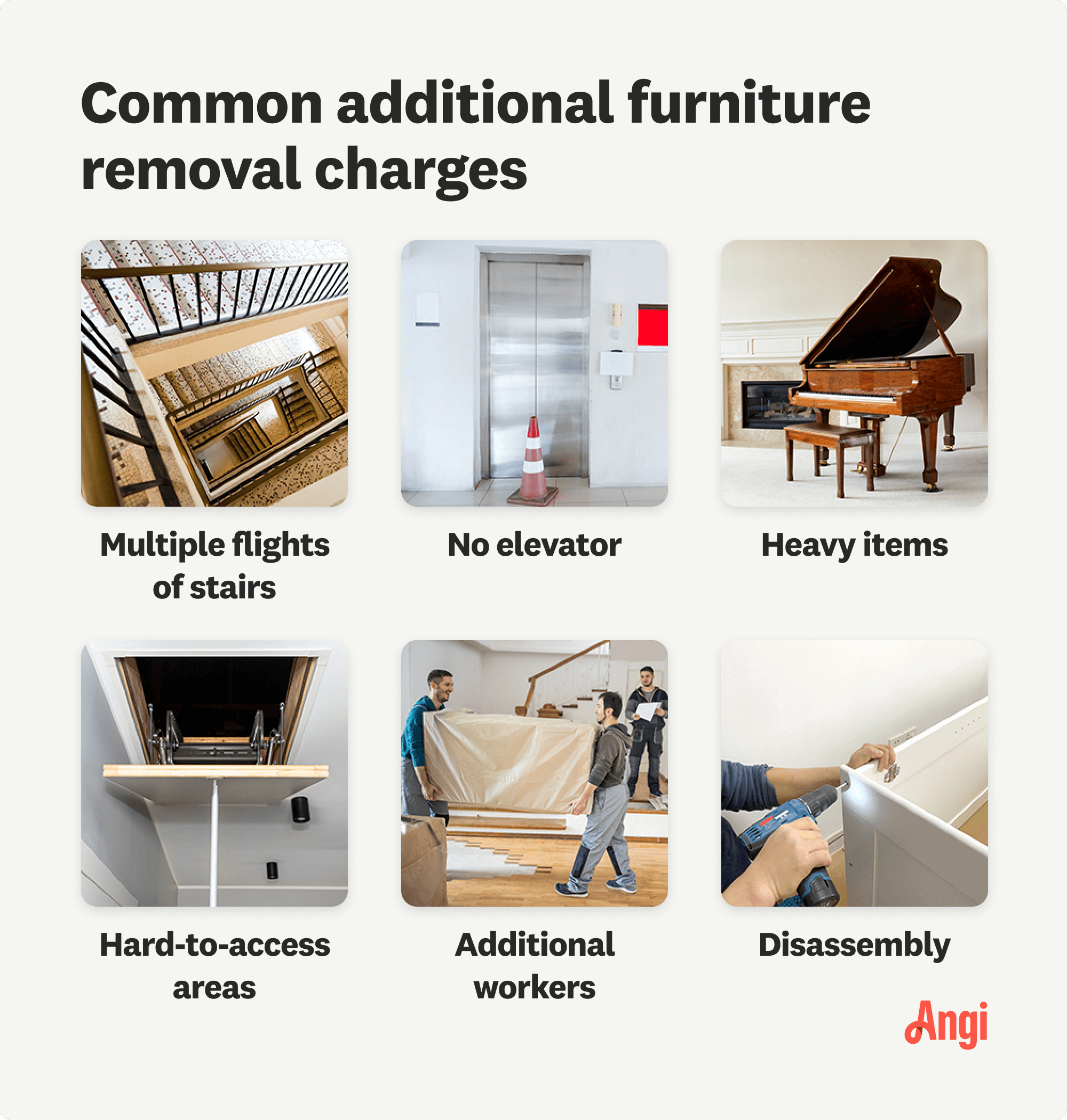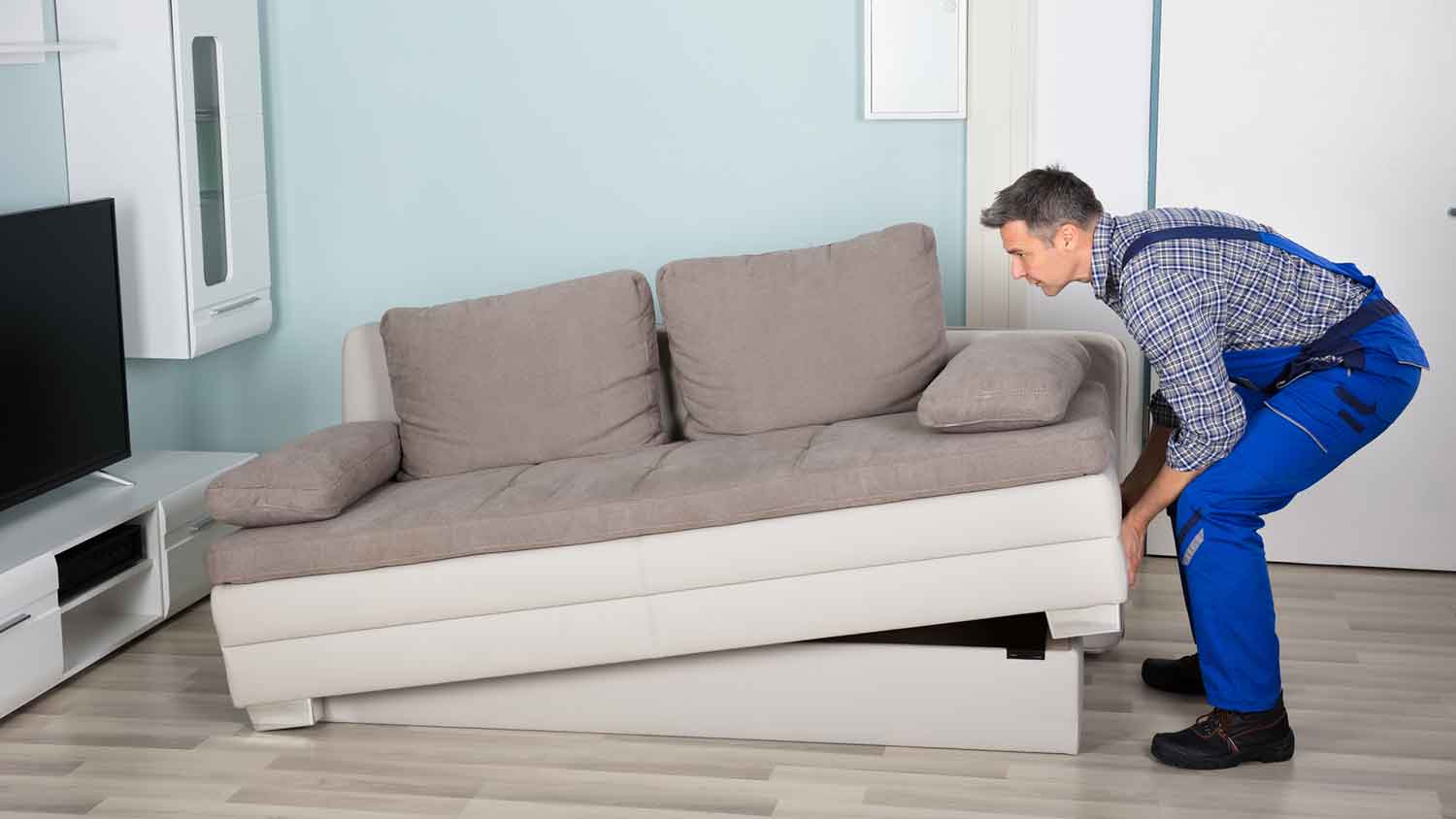
Removing a hot tub costs an average of $400. Learn what factors affect hot tub removal costs, including size, type of hot tub, and disposal method.
The average U.S. homeowner pays around $180 for furniture removal. Costs can sit anywhere between $50 and $400, depending on the furniture’s size, type, and location.


Large, heavy, or cumbersome furniture items cost more to remove than small, easily moved items.
Donating your items if they’re in good shape or taking them to a landfill yourself are the cheapest ways to dispose of furniture.
Hiring a junk removal company is recommended when you have several pieces to be taken away, and renting a dumpster is a good idea if you’re updating your furniture as part of a home renovation.
Consider working a tip into your budget if you hire a junk removal company.
Buying new furniture? Having your old furniture removed costs an average of $180, with prices commonly ranging from $75 to $250. Removing heavy furniture on your own is inconvenient, especially if you don’t have a truck or van to load up.
Don’t let unwanted furniture take up valuable space in your home. Hire a junk removal company to remove your old furniture so you can focus on the fun parts of redecorating.
When it’s time to redecorate, you want your home to be out with the old and in with the new. Old furniture can be hard to get rid of, requiring heavy lifting, a truck or van, and time to drive to the landfill. Hiring a local junk removal company to remove your furniture saves you the time and hassle of disposing of your old items, but furniture removal costs vary depending on several factors.
Some junk removal companies charge per item depending on the type of furniture being removed. Larger or heavier items like sectional couches or patio sets cost more to remove than smaller items like mattresses or chairs.
| Type of Furniture | Average Removal Cost |
|---|---|
| Mattress | $75–$100 |
| Couch | $75–$150 |
| Sectional | $100–$175 |
| Armchair | $50–$100 |
| Patio set | $150–$250 |
| Table | $50–$100 |
Expect to pay more if you’re getting rid of multiple pieces of furniture. If the junk removal company charges by weight instead of furniture type, you’ll pay a flat fee per pound.
If the company charges based on the number or type of furniture items, ask if they offer a discounted rate for multiple items. Some companies don’t charge the full amount for additional items if they’re already taking something else.
How you get rid of your furniture will affect how much it costs. Bringing it to the landfill is the most cost-effective method, but you’ll need a way to get it there and will need to find someone to help you lift and carry it. A junk removal company is less expensive than renting a dumpster, but a dumpster will allow you to clear out more stuff at a more convenient pace.
| Furniture Removal Method | Average Cost |
|---|---|
| Junk removal company | $75–$250 |
| Dumpster rental | $300–$500 |
| Bring to the landfill | $10–$50 |
| Donate | $0 |
If your furniture is hard to get to, difficult to carry, or challenging to remove, your bill may be higher. Removing furniture from an apartment building with no freight elevator or the top floor of a multi-story home with narrow stairs can cost more.
Very heavy pieces or large items that need to be disassembled to fit through the door may also incur an extra charge. Let the company know when booking your pickup if any of your furniture may be difficult to access or remove.

Most junk removal companies charge based on a set number of workers—often two people—and a maximum amount of time per job. If removing your furniture will require extra time or labor, expect to pay more.
Tipping isn’t mandatory for junk removal, but if you’d like to show your appreciation for a job well done, tip junk haulers 5 to 10% of the total cost or $10 to $20 per worker. A tip will be especially appreciated if the job involves a lot of heavy lifting, multiple flights of stairs, or extra work like disassembly.
Where you live can affect how much you pay for furniture removal. Landfill fees, gas prices, travel times to your home and the landfill, and more all contribute to the cost of hiring a junk removal company. Here’s how average costs for a load of junk removal vary by location.
| Location | Average Cost |
|---|---|
| New York, NY | $350 |
| Los Angeles, CA | $300 |
| Miami, FL | $250 |
| Chicago, IL | $240 |
| Phoenix, AZ | $200 |
| Atlanta, GA | $190 |
| Austin, TX | $190 |

If you’re able to lift and haul away furniture yourself without renting a vehicle to do so, you’ll pay $10 to $50 per large item to dispose of the furniture at a landfill. Plus, you’ll need to factor in the cost of gas to drive a vehicle large enough to haul furniture, especially if you need to make multiple trips.
You could save yourself the sweat (and back pain), though, by hiring a junk removal pro near you. These pros already have the vehicles and supplies necessary to safely, quickly remove even your largest unwanted furniture.
Save yourself the hassle of lifting and hauling away old furniture. Here are the many benefits of hiring a pro for furniture removal:
Furniture is heavy, and you could strain your back, neck, or arms by trying to carry these items.
Pros have the heavy-duty vehicles needed to haul furniture, so you won’t have to ask a friend or neighbor to borrow their truck.
Pros have special equipment and supplies if they need to take apart the furniture to fit it through doors or into a truck.
Junk removal pros will not only do the heavy lifting (literally), but they’ll also handle the entire disposal process, so you won’t have to drive out to the junk yard.
Pros can move furniture out as quickly and safely as possible.
We recommend hiring a pro for bulky furniture removal, but you can still help out with these tasks:
Take apart furniture before junk removal pros arrive.
Clear pathways from the furniture to exterior doors to make removal more efficient.
Bring pets inside and crate them or keep them in one room to prevent them from coming underfoot of the junk haulers.
Hauling away old furniture on your own is a good option if you’re physically able to move the items and have a truck or van that can accommodate them. If you bring your old furniture to the landfill, expect to pay about $10 to $50 per large item.
If you don’t have a vehicle big enough to hold furniture or can’t lift heavy items, hire someone who can haul junk away to remove your old furniture.
A junk removal company can take more than just your old furniture. It may be cost-effective to get rid of other items at the same time that the company is already at your house.
General junk removal costs between $75 and $650, depending on the size of the load.
Appliance removal costs an average of $60 to $180 per item.
Construction debris removal averages between $100 and $800.
If you’re looking for a budget-friendly way to dispose of old furniture, especially if your items are still in good condition, you have a few options. They may involve more work than hiring someone to remove and dispose of your furniture, but they will be a little easier on your budget.
If your items are still usable and might be appreciated by someone looking for a low-cost or free way to get furniture, list them on a local sales or giveaway site or forum like Facebook Marketplace or Freecycle. Make sure you’re clear the recipient will need to pick up the items—you’ll need to bring it outside, but they’ll take it from there.
Many nonprofits will take furniture donations that are in good condition, so this is a great option if you’re replacing furniture that’s still clean, intact, and in good shape. Find a local organization that will pick up the items to find out their donation guidelines and process. You might even be able to use the donation as a tax write-off.
If you’re doing a whole-house overhaul or need to get rid of a lot of unwanted items at once after a cleanout, consider renting a dumpster. Rental companies have guidelines regarding what you can and can’t put in a dumpster, but as long as you don’t have hazardous or other prohibited materials, you can clear out a large amount of trash, including furniture, for a flat fee. Dumpsters cost an average of $300 to $800 per week for a 20-yard dumpster.
While there are federal guidelines for hazardous waste, each state and town also has its own unique guidelines. Make sure to check with your local government to understand its waste disposal regulations before starting your next removal project.
Some municipal or private trash services will pick up furniture left out for collection. Services have different guidelines for what’s accepted and when and where it’ll be picked up. They often require advance notice, so contact your trash collection service to find out how to proceed.
Provide a list and description of what furniture items you need a pro to haul away.
Take measurements of the furniture and your doorways. Pros will also take measurements, but providing these numbers up front will help you get more accurate quotes.
Ask about the pro’s insurance coverage for workers and personal property in case of any accidents.
If sustainability or reuse are important to you, consider asking about the company’s policies around how items are disposed of. Some companies may offer to donate or recycle your items for you.
Home is the most important place on earth, which is why Angi has helped more than 150 million homeowners transform their houses into homes they adore. To help homeowners with their next project, Angi provides readers with the most accurate cost data and upholds strict editorial standards. We extensively research project costs to develop the pricing data you see, so you can make the best decisions for you and your home. We rely on reputable sources, including the U.S. Bureau of Labor Statistics, academic journals, market studies, and interviews with industry experts—all to ensure our prices reflect real-world projects.
Want to help us improve our cost data? Send us a recent project quote to [email protected]. Quotes and personal information will not be shared publicly.
From average costs to expert advice, get all the answers you need to get your job done.

Removing a hot tub costs an average of $400. Learn what factors affect hot tub removal costs, including size, type of hot tub, and disposal method.

Junk removal costs depend on the volume and type of waste you need removed, but paying a professional saves you time and energy over hauling it yourself.

Shed removal costs depend on size, materials, condition, and if you DIY the demolition or not. This guide will help you budget to remove your shed.

Ensure your old mattress is disposed of legally and responsibly by hiring a junk removal service.

Whether you’re redoing your patio or driveway, understanding how to dispose of concrete properly is an important step in your project.

From that old gas grill to piles of torn-up linoleum, you may be wondering, "Who can haul my junk away?" Here's who to call when your junk is piling up.